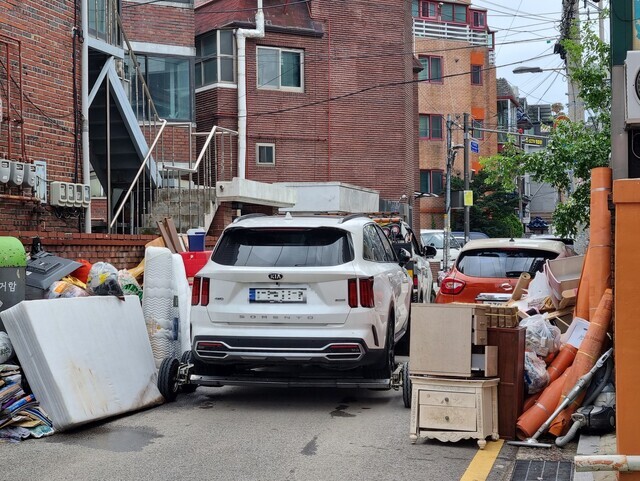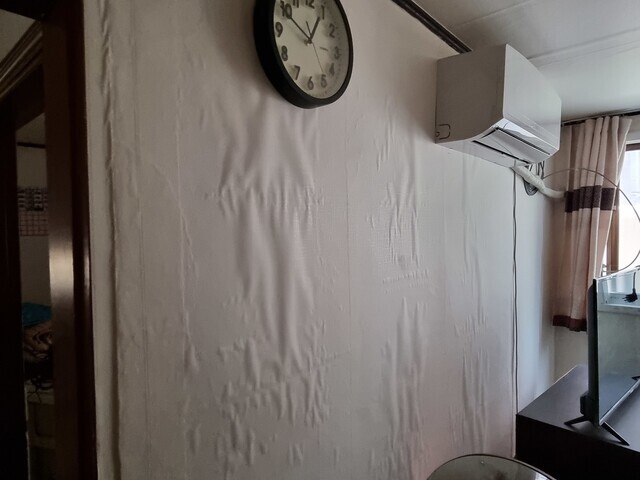hankyoreh
Links to other country sites 다른 나라 사이트 링크
“Can’t help but cry”: Those hit hardest by Seoul flooding face uncertain futures

“What can we do when one refrigerator would cost 800,000 to 900,000 won to buy? We don’t have that sort of money.”
On Thursday, the Hankyoreh met with a 71-year-old individual surnamed Yu, who lives in a semi-basement unit located in the Sillim neighborhood of Seoul’s Gwanak District. Since Tuesday, Yu has been washing household items like spoons and ladles with diluted bleach at the parking lot next to the multi-household building she lives in. Lining the inside of the parking lot were other major household items Yu and her husband had taken out of their semi-basement apartment: a refrigerator, a laundry rack, a vacuum cleaner and more.
Yu’s home was completely flooded by the torrential rain that hit Seoul on Monday and Tuesday.
“It took all our lives to buy all these things, so I can’t help but cry,” Yu said, sighing repeatedly. “Buying them new won’t be easy. My health is not great, and my husband can’t hear very well from working in construction for around 30 years, and they don’t hire people like him.”

The Gwanak and Dongjak districts of Seoul, which suffered some of the worst flooding damage in the city, were reminiscent of battlefields after heavy rains raged across the area. On Wednesday and Thursday, the Hankyoreh found Gwanak District’s narrow alleyways lined with multi-household buildings packed with furniture semi-basement dwellers had taken out of their homes to the streets. Trash was being hauled into garbage trucks, and soldiers belonging to the Army Special Warfare Command worked in groups to carry water-damaged waste from flooded apartments onto the road.
In the residential area in the Sillim neighborhood of the Gwanak District where two sisters in their 40s and a daughter died Monday night, heaps of linoleum, furniture, clothes, and mattresses riddled the streets on both sides. A 52-year-old surnamed Kim who lives in a semi-basement unit 100 meters away from the spot the three women died said, “I got dizzy when I heard the news that people had died.”
Some residents said they actually feared for their lives during the downpour. A 63-year-old surnamed Lim who lives in a semi-basement unit with her husband said, “While I was at the community center to borrow a water pump, my husband, who was trying to close the front door of the apartment so water wouldn’t get into the house, got trapped inside.” She continued, “Emergency responders removed the window and rescued my husband, who was on top of the piano, and he might have really died if they had gotten here even a little later.”
“I hear it will be raining again, and I’m worried that the house will flood again,” she added with a frown.

The downpour indelibly damaged countless homes. A 66-year-old surnamed Baek, whom the Hankyoreh met in front of a multi-household building in the Sindaebang 1 neighborhood of Seoul’s Dongjak District Wednesday afternoon, lifted the linoleum underneath the dresser in his semi-basement room. Pointing at the dark stains on the floor, he said, “These stains are from water that overflowed from the toilet. I can’t get rid of it. The smell won’t go away even when I spray chemicals on them.”
Residents affected by flooding are staying at temporary shelters or with family or relatives for now, but they aren’t exactly in the position to look for alternate housing options. Sim In-taek, a 75-year-old resident of the Dongjak District, said as if in resignation, “I’m a welfare recipient, so even with the money I borrowed from the state, I don’t have a lot of options.”

By Seo Hye-mi, staff reporter
Please direct questions or comments to [english@hani.co.kr]

Editorial・opinion
![[Column] Season 2 of special prosecutor probe may be coming to Korea soon [Column] Season 2 of special prosecutor probe may be coming to Korea soon](https://flexible.img.hani.co.kr/flexible/normal/500/300/imgdb/original/2024/0426/3317141030699447.jpg) [Column] Season 2 of special prosecutor probe may be coming to Korea soon
[Column] Season 2 of special prosecutor probe may be coming to Korea soon![[Column] Park Geun-hye déjà vu in Yoon Suk-yeol [Column] Park Geun-hye déjà vu in Yoon Suk-yeol](https://flexible.img.hani.co.kr/flexible/normal/500/300/imgdb/original/2024/0424/651713945113788.jpg) [Column] Park Geun-hye déjà vu in Yoon Suk-yeol
[Column] Park Geun-hye déjà vu in Yoon Suk-yeol- [Editorial] New weight of N. Korea’s nuclear threats makes dialogue all the more urgent
- [Guest essay] The real reason Korea’s new right wants to dub Rhee a founding father
- [Column] ‘Choson’: Is it time we start referring to N. Korea in its own terms?
- [Editorial] Japan’s rewriting of history with Korea has gone too far
- [Column] The president’s questionable capacity for dialogue
- [Column] Are chaebol firms just pizza pies for families to divvy up as they please?
- [Column] Has Korea, too, crossed the Rubicon on China?
- [Correspondent’s column] In Japan’s alliance with US, echoes of its past alliances with UK
Most viewed articles
- 1After election rout, Yoon’s left with 3 choices for dealing with the opposition
- 2AI is catching up with humans at a ‘shocking’ rate
- 3Noting shared ‘values,’ Korea hints at passport-free travel with Japan
- 4Why Kim Jong-un is scrapping the term ‘Day of the Sun’ and toning down fanfare for predecessors
- 5Two factors that’ll decide if Korea’s economy keeps on its upward trend
- 6South Korea officially an aged society just 17 years after becoming aging society
- 7Korea’s 1.3% growth in Q1 signals ‘textbook’ return to growth, says government
- 8Is Japan about to snatch control of Line messenger from Korea’s Naver?
- 91 in 5 unwed Korean women want child-free life, study shows
- 10[Reportage] On US campuses, student risk arrest as they call for divestment from Israel